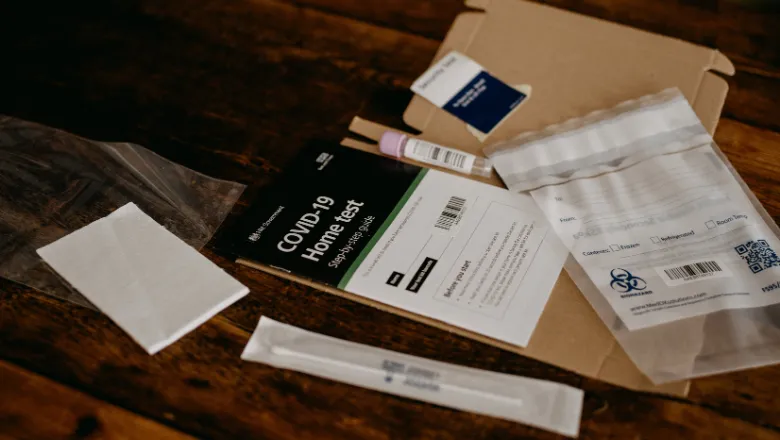The identification of this combination of symptoms through the COVID Symptom Study app is another prime demonstration of the value of big data analytics and mobile health technology to support the management of this pandemic. Daily self-reported symptoms from a mobile application at the scale of an entire country has offered a new perspective for public health research and response towards the rapid spread of infectious diseases such as COVID-19.
Professor Sebastien Ourselin from the School of Biomedical Engineering & Imaging Sciences
17 February 2021
'Classic triad' of symptoms misses positive COVID-19 cases, study finds
Extending the symptoms that trigger a PCR test for COVID-19 could help detect around a third more cases of the disease.

New research led by researchers at King’s and published in the Journal of Infection suggests that restricting testing to the ‘classic triad’ of cough, fever and loss of smell which is required for eligibility for a PCR test through the NHS may have missed cases. Extending the list to include fatigue, sore throat, headache and diarrhoea would have detected 96% of symptomatic cases.
A team of researchers at King’s and the Coalition for Epidemic Preparedness Innovations (CEPI) analysed data from more than 122,000 UK adult users of the ZOE COVID Symptom Study app. These users reported experiencing any potential COVID-19 symptoms, and 1,202 of those reported a positive PCR test within a week of first feeling ill.
While PCR swab testing is the most reliable way to tell whether someone is infected with the SARS-CoV-2 coronavirus that causes COVID-19, the analysis suggests the limited list of three does not catch all positive cases of COVID-19.
Testing people with any of the three ‘classic’ symptoms would have spotted 69% of symptomatic cases, with 46 people testing negative for every person testing positive. However, testing people with any of seven key symptoms - cough, fever, anosmia, fatigue, headache, sore throat and diarrhoea - in the first three days of illness would have detected 96% of symptomatic cases. In this case, for every person with the disease identified, 95 would test negative.
Researchers also found users of the Symptom Study App were more likely to select headache and diarrhoea within the first three days of symptoms, and fever during the first seven days, which reflects different timings of symptoms in the disease course. Data from the ZOE app shows that 31% of people who are ill with COVID-19 don’t have any of the triad of symptoms in the early stages of the disease when most infectious.
The researchers applied a multi-objective evolutionary algorithm (MOEA) to generate a set of optimal symptom combinations, each characterised by a good trade-off between specificity and sensitivity. MOEA starts generating a population of random symptom combinations and then evolves that population towards better combinations ending with a set of optimal symptom combinations. The choice of the optimal combination to use depends on the testing capacity.
Cough or dyspnoea (shortness of breath) were reported by 46% of individuals positive for COVID-19 within the first three days of symptom onset. When users reported fever, the sensitivity increased to 60%, while logging anosmia/ageusia increased sensitivity to 69%. When headache and fatigue was added the proportion of COVID-19 cases increased to 92% but the tests per case doubled.
The findings may be valuable in situations where there is a limited testing capacity. Researchers suggest a range of optimal symptom combinations that could be used in vaccine efficacy trials or in public health settings, when assessing financial and logistical resources.
Dr Claire Steves, Reader at the School of Life Course Sciences, said: “There are many symptoms which occur in acute COVID, including some like fatigue and headache which are also common in other conditions. Depending on the testing available, different symptom combinations can be used to be as sensitive or specific as possible. We hope these models are of use in a range of settings – from vaccine trials to detecting and treating COVID outbreaks going forward.”
Professor Tim Spector from the School of Life Course Sciences said: “We’ve known since the beginning that just focusing testing on the classic triad of cough, fever and anosmia misses a significant proportion of positive cases. We identified anosmia as a symptom back in May and our work led to the government adding it to the list, it is now clear that we need to add more. By inviting any users who log any new symptoms to get a test, we confirmed that there are many more symptoms of COVID-19. This is especially important with new variants that may cause different symptoms. For us, the message for the public is clear: if you’re feeling newly unwell, it could be COVID and you should get a test.”
Dr Jakob Cramer, Head of Clinical Development, at the Coalition for Epidemic Preparedness Innovations, said: “Accurate diagnosis of COVID-19 cases is crucial when assessing the efficacy of COVID-19 vaccine candidates in large-scale studies, especially since the signs and symptoms associated with the disease are extensive and overlap with other common viral infections. The findings of this study provide important insights that will help optimise the choice of triggering symptoms for diagnostic work-up in COVID-19 vaccine-efficacy trials. We hope the findings of this study will not only aid CEPI’s COVID-19 vaccine-development partners but also the wider R&D community.”



